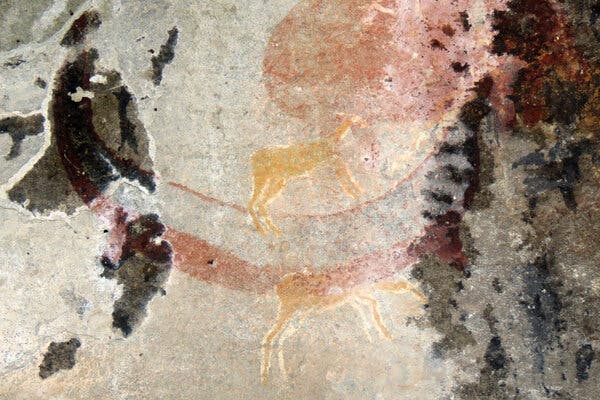Trilobites
The artwork suggests that the San people of South Africa have an Indigenous knowledge of paleontology that predated Western approaches to the field.

On a sandstone cliff in South Africa, a series of paintings recount a riveting battle. Spears fly as shield-wielding warriors charge. Animals, including an aardvark and scores of antelope, fringe the fracas.
This dramatic rock art, known as the Horned Serpent panel, is estimated to be more than 200 years old. In addition to the well-known wildlife of the region, it also features a Seussian creature with the elongated body of a lizard and the tusked mug of a walrus. Its skin is covered in polka dots. This bizarre beast is unlike anything found in South Africa over recent centuries. What could it be?
A paper published Wednesday in the journal PLOS One posits that this mythic monster was inspired by local fossils of long extinct animals. The author of the study suggests that the Indigenous southern African people who painted the Horned Serpent panel, the San, developed paleontological knowledge about their region that predated the contemporary Western approach to studying creatures that disappeared millions of years ago.
Julien Benoit, the author of the study and a paleontologist at the University of the Witwatersrand in Johannesburg, came across a description of the Horned Serpent rock art in a 1930 tome. The book’s illustration of the tusked creature intrigued him. “I immediately thought that this could be a dicynodont,” Dr. Benoit said.
Dicynodonts were burly reptilelike ancestors of mammals. These large herbivores had a turtle-like beak and a pair of tusks. They were among the few groups to survive the End-Permian mass extinction around 250 million years ago and make it into the Triassic Period, where they lumbered alongside early dinosaurs. But they went extinct 200 million years ago, long before the earliest humans, let alone the San, could paint them.
To understand the Horned Serpent’s origins better, Dr. Benoit set out to find the original rock wall where it was painted in a mountainous area of central South Africa.



